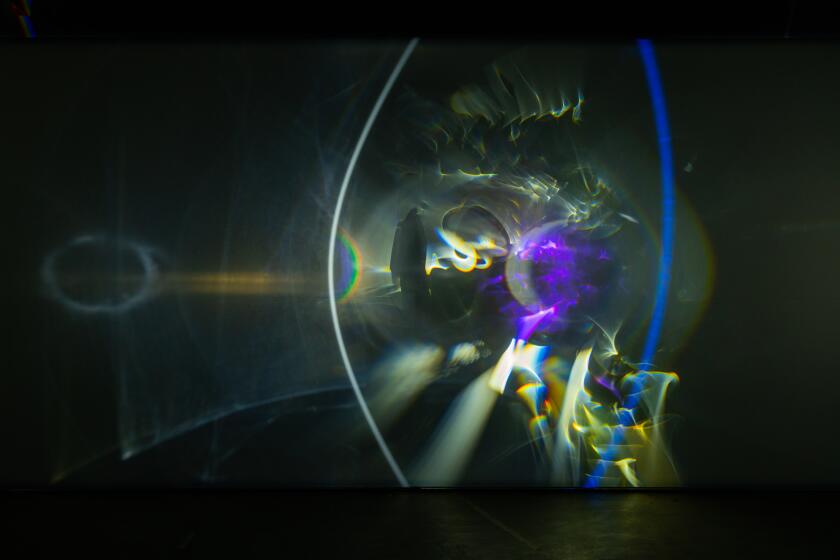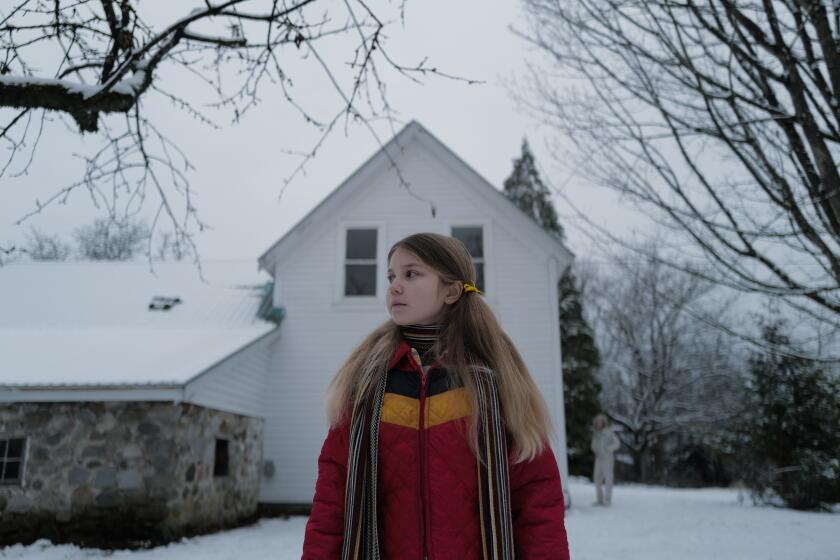Seeing Terrence Malick films through his use of music. His composers share what they know
Terrence Malick’s films are like dance pieces. His characters don’t stand still — they glide, they twirl, they run. His camera never rests, either. And the center of his films isn’t story, or dialogue, or character. It’s a spiritual theme — a question — examined through motion and music.
“A Hidden Life,” his latest, is based on the true story of an Austrian farmer who refuses to pledge loyalty to Hitler, and the director tells it in the same elliptical, poetic style he’s been exploring since 1978’s “Days of Heaven.” It has an elegiac score by James Newton Howard, featuring violin solos by James Ehnes and a main theme that conjures the heartbreaking beauty of paradise lost. But, as with all of the director’s films, it also features a collage of classical masterworks.
Malick’s soundtracks are a kind of musical “free association,” in the words of Alex Ross, music critic of the New Yorker. “That sort of kaleidoscopic quality of music of the present, music of the past, many different styles, is integral, or just matches the general visual aesthetic of these films very well,” said Ross.
That mix of original music and older compositions doesn’t always pass muster with the academy’s music branch. For that very reason, Howard, the eight-time Oscar-nominated composer of “The Fugitive” and “The Village,” is ineligible for Oscar consideration. It’s simply the price of admission to work with one of today’s eminent auteurs.
“I’m thrilled,” Howard said. “It was a notch I wanted on my gun.”
Howard recalled recently talking to his friend Hans Zimmer, who scored “The Thin Red Line” for Malick in 1998. Zimmer said, “Oh, you did Terry’s movie. I love Terry.” “You know, you do love Terry,” agreed Howard, “no matter how elusive finishing the task can be — because it can be sometimes elusive. “ (Malick declined to participate in this story).
Malick’s game of musical chairs began with “Badlands,” the director’s first and most conventional film. The outlaws-on-the-run drama, starring Martin Sheen and Sissy Spacek, had an underscore by George Tipton (“The Golden Girls”) and some tunes by James Taylor, but the main thrust was a recurring use of Carl Orff’s childlike piece for xylophone, “Gassenhauer.”
“He’s definitely way more comfortable using existing classical pieces if he can,” said editor Billy Weber, who collaborated with Malick on everything from “Badlands” to “The Tree of Life.” “That’s what he’s used to from his life. He was a wonderful keyboardist, and he could play the organ and piano and he has a vast knowledge of classical music.”
A musical canvas
In “Days of Heaven,” Malick began favoring narration and impressionistic editing over traditional dialogue scenes. A filmmaking style was born, one that provided a unique and outsized canvas for music. Malick asked composer Ennio Morricone to incorporate “Aquarium” from Camille Saint-Saëns’ “The Carnival of the Animals,” which plays in its original form under the opening titles of “Days of Heaven,” lending the film a fairy tale feel.
Based on phone conversations, Morricone wrote 18 themes for Malick to choose from. One was a musical inversion of “Aquarium,” which became the film’s central theme. Morricone gave Malick permission to mix and match the various pieces wherever he pleased — which Malick did — with one exception: the music Morricone wrote for the wheat field fire.
The score earned Morricone an Oscar nomination. In this case, the academy thought the original score was good enough — and plentiful enough — to merit inclusion.
“His film describes a world outside of time, a magic place where poetry and reality coexist,” Morricone wrote in his 2019 memoir. “It is one of the films I feel closest to, even after such a long time.”
Then Malick famously took a 20-year sabbatical. When he returned to make “The Thin Red Line,” he did so with a mature evolution of his aesthetic.
Zimmer remembers attending an “artistic dinner party” full of painters and poets and writers — among them Malick and director Werner Herzog. “When the room suddenly, by accident, goes completely silent, you could just hear Terry and Werner arguing about which cue of ‘The Lion King’ they preferred,” said Zimmer, who composed the score for the film. “I was somewhat flattered.”
Malick and Zimmer spent a year hanging out in the composer’s studio, talking about what kind of film it should be. “I remember we only spoke about the script once,” said Zimmer. “After that, we just spoke about painting, we spoke about baroque churches in Bavaria, we spoke about philosophy, we spoke about colors. We spoke a lot about color.”
As Malick whittled his initial five-hour cut in half, whole characters were jettisoned, as was much of the dialogue.
“We had bad arguments,” said Zimmer, laughing. “The script was full of words, and then he started taking all the words out, and basically put all that on my shoulders. It took me a while to realize that we were basically going to end up with music and images far more than dialogue.”
Unorthodox as it was, the film inspired Zimmer to write one of his most mature, minimalistic scores to date — a meditative lament that set the film’s dirge-like mood and rhythm.
It later influenced the way he worked with Christopher Nolan on films like “Inception,” “where a piece of music would exist autonomously and independently of the film, and somehow the two would merge and then become a whole,” Zimmer said.
Malick also used music by Gabriel Fauré, Charles Ives and Arvo Pärt (Zimmer’s mother knew Pärt’s mother, it turns out, so obtaining rights was easy), and the basis for some of Zimmer’s score — which was nominated for an Oscar — was an American folk hymn the director heard on NPR.
Playing by Malick’s rules
Zimmer recalled that Malick loved a particular recording of Wagner’s “Das Rheingold” and wanted to use it in the film over the composer’s objections. After much debate, he was able to persuade Malick not to use it. A few years later when Zimmer attended the premiere of Malick’s next film, “The New World,” “it sort of made me laugh,” he said. “Suddenly there was that piece!”
Not laughing was that film’s composer, James Horner, who definitely had the hardest time playing by Malick’s rules.
“I would sum up Terry as being a brilliant photographer, and that’s where it stops,” the late composer told Film Music Radio in 2006. In a lengthy diatribe, a bitter Horner relayed his bewilderment with Malick’s editing process and nonlinear storytelling — and his eventual reliance on repertoire pieces.
“Terry is like, on the surface, a stone, and he does not know how to tell a love story to save his life,” Horner said. “When we scored the movie, he completely disassembled everything. The score made no sense anymore, and he started to stick in Wagner over scenes — it was so preposterous — and a Mozart piano concerto over an Indian attack. Everybody, to a man, thought he was insane.”
But the director’s use of the prelude to “Das Rheingold” in that film is one of his many brilliant employments of the classical repertoire, argued Ross. Wagner’s opera begins with the beginning of the world, pure and untouched by human power and strife.
“It leads into the scene of the three Rhinemaidens at play in the waters of the Rhine, where the gold lies buried,” said Ross. “And in the film, you see three young Native American women swimming in the water.”
“Hidden just in that single musical reference is a whole kind of essay on how the white colonization of the North American continent is a story of power and oppression,” he continued. “For me, it’s absolutely one of the greatest uses of Wagner in film.”
Alexandre Desplat, who wrote an original score for “The Tree of Life,” was much more comfortable with Malick’s process. He wrote about a dozen ideas based on the script, some of which made it into the film — but Malick ultimately favored an eclectic array of concert music, from Smetana’s “The Moldau” to a series of requiems and funeral music by Berlioz, Górecki and Zbigniew Preisner.
“What you’re watching in ‘The Tree of Life’ is Terry’s life,” said Weber. “That’s the first time he ever allowed anything, in any movie he’d ever done, that had any inkling of himself in it, and so it meant so much to him. It was really so personal.”
The films that followed — “To the Wonder,” “Knight of Cups” and “Song to Song” — continued the pattern: meaningful selections of classical music, interspersed with new score by a young composer from New Zealand, Hanan Townshend, who was based in Austin, Texas.
Howard knew what he was signing up for when he agreed to score “A Hidden Life.”
“I was worshipful of the first couple of movies, like most people,” said Howard. “I absolutely loved ‘The New World.’ I was sad for James, because I know that that didn’t go well. I guess when you see what other people’s experiences are with a director, you’re more educated. You need to go in with your eyes open — which I did, and never had any problem at all.”
Malick and Howard began by discussing the film’s spiritual themes: “a battle of light and darkness,” “a feeling of Shangri-La, a garden of Eden,” “the suffering inherent in love.” As he has with other composers — with echoes of “Das Rheingold” — Malick specifically asked for a theme inspired by a river, here the one flowing through the village of St. Radegund.
Howard responded with a bittersweet violin theme that soars over a babbling brook of piano arpeggios.
“There’s a sadness about love, a melancholy and a sadness about beauty,” said Howard. “It’s just part of the human experience of living on this planet.”
That melody becomes frightened or queasy with worry as the plight of the protagonist, Franz (played by August Diehl), intensifies. Elsewhere, Malick uses music by Handel to accompany footage of Hitler, Pärt to convey the bleak tragedy of Franz’s situation, and Górecki’s “Kleines Requiem” to toll the death knell.
“I approve of all of his classical choices,” said Howard. “I think the stuff he put in there is absolutely gorgeous. I wasn’t worried about it being a mashup.”
Malick rarely uses the same composer twice.
“He keeps trying to figure out which question to ask, and then figure out if one should answer it or not,” Zimmer noted. “And one of the best ways of doing that is by changing composers on every movie, or as much as possible, because you will get a different point of view to some of the same questions.
“I think the ultimate piece of music for Terry has to be Charles Ives’ ‘Unanswered Question.’ Because I think that’s Terry’s life, you know, that’s his mission in life — the unanswered question.”
More to Read
Only good movies
Get the Indie Focus newsletter, Mark Olsen's weekly guide to the world of cinema.
You may occasionally receive promotional content from the Los Angeles Times.









